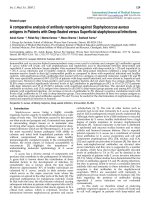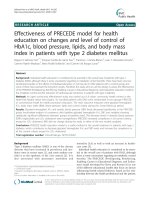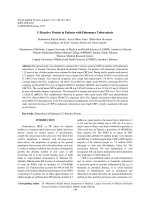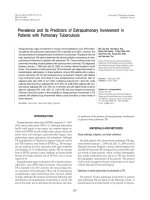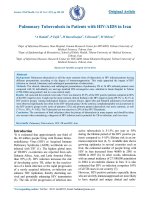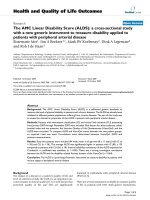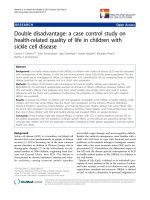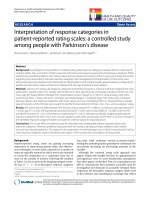Intensive Lipid Lowering with Atorvastatin in Patients with Stable Coronary Disease pot
Bạn đang xem bản rút gọn của tài liệu. Xem và tải ngay bản đầy đủ của tài liệu tại đây (149.21 KB, 12 trang )
Intensive Lipid Lowering
with Atorvastatin
in Patients with Stable
Coronary Disease
n engl j med
352;14
www.nejm.org april
7, 2005
The
new england journal
of
medicine
1425
original article
Intensive Lipid Lowering with Atorvastatin
in Patients with Stable Coronary Disease
John C. LaRosa, M.D., Scott M. Grundy, M.D., Ph.D.,
David D. Waters, M.D., Charles Shear, Ph.D., Philip Barter, M.D., Ph.D.,
Jean-Charles Fruchart, Pharm.D., Ph.D., Antonio M. Gotto, M.D., D.Phil.,
Heiner Greten, M.D., John J.P. Kastelein, M.D., James Shepherd, M.D.,
and Nanette K. Wenger, M.D., for the Treating to New Targets (TNT) Investigators*
From the State University of New York
Health Science Center, Brooklyn (J.C.L.); the
University of Texas Southwestern Medical
Center, Dallas (S.M.G.); San Francisco Gen-
eral Hospital, San Francisco (D.D.W.); Pfizer,
Groton, Conn. (C.S.); the Heart Research In-
stitute, Sydney (P.B.); Institut Pasteur, Lille,
France (J C.F.); Weill Medical College of
Cornell University, New York (A.M.G.); Uni-
versitätsklinikum Eppendorf, Hamburg,
Germany (H.G.); Academic Medical Cen-
ter, University of Amsterdam, Amsterdam
(J.J.P.K.); the University of Glasgow, Glas-
gow, United Kingdom (J.S.); and Emory Uni-
versity School of Medicine, Atlanta (N.K.W.).
Address reprint requests to Dr. LaRosa at
the State University of New York Health
Science Center, 450 Clarkson Ave., Brooklyn,
NY 11203, or at
*Participants in the TNT Study are listed
in the Appendix.
This article was published at www.nejm.
org on March 8, 2005.
N Engl J Med 2005;352:1425-35.
Copyright © 2005 Massachusetts Medical Society.
background
Previous trials have demonstrated that lowering low-density lipoprotein (LDL) choles-
terol levels below currently recommended levels is beneficial in patients with acute cor-
onary syndromes. We prospectively assessed the efficacy and safety of lowering LDL
cholesterol levels below 100 mg per deciliter (2.6 mmol per liter) in patients with stable
coronary heart disease (CHD).
methods
A total of 10,001 patients with clinically evident CHD and LDL cholesterol levels of less
than 130 mg per deciliter (3.4 mmol per liter) were randomly assigned to double-blind
therapy and received either 10 mg or 80 mg of atorvastatin per day. Patients were fol-
lowed for a median of 4.9 years. The primary end point was the occurrence of a first
major cardiovascular event, defined as death from CHD, nonfatal non–procedure-relat-
ed myocardial infarction, resuscitation after cardiac arrest, or fatal or nonfatal stroke.
results
The mean LDL cholesterol levels were 77 mg per deciliter (2.0 mmol per liter) during
treatment with 80 mg of atorvastatin and 101 mg per deciliter (2.6 mmol per liter) dur-
ing treatment with 10 mg of atorvastatin. The incidence of persistent elevations in liver
aminotransferase levels was 0.2 percent in the group given 10 mg of atorvastatin and
1.2 percent in the group given 80 mg of atorvastatin (P<0.001). A primary event oc-
curred in 434 patients (8.7 percent) receiving 80 mg of atorvastatin, as compared with
548 patients (10.9 percent) receiving 10 mg of atorvastatin, representing an absolute
reduction in the rate of major cardiovascular events of 2.2 percent and a 22 percent rel-
ative reduction in risk (hazard ratio, 0.78; 95 percent confidence interval, 0.69 to 0.89;
P<0.001). There was no difference between the two treatment groups in overall mortality.
conclusions
Intensive lipid-lowering therapy with 80 mg of atorvastatin per day in patients with sta-
ble CHD provides significant clinical benefit beyond that afforded by treatment with
10 mg of atorvastatin per day. This occurred with a greater incidence of elevated amino-
transferase levels.
abstract
Copyright © 2005 Massachusetts Medical Society. All rights reserved.
Downloaded from www.nejm.org at RIKSHOSPITALET HF on February 18, 2008 .
n engl j med
352;14
www.nejm.org april
7
,
2005
The
new england journal
of
medicine
1426
he value of lowering low-density
lipoprotein (LDL) cholesterol levels in pre-
venting major cardiovascular events and
stroke has been well documented. Recent studies
have raised the issue of optimal treatment targets
for patients with coronary heart disease (CHD).
1-4
The value of reducing LDL cholesterol levels sub-
stantially below 100 mg per deciliter (2.6 mmol per
liter) in patients with CHD, particularly those with
stable nonacute disease, has not been clearly dem-
onstrated.
The Third Report of the National Cholesterol Ed-
ucation Program (NCEP) Adult Treatment Panel
5
and the most recent guidelines of the Third Joint
Task Force of European and Other Societies on Car-
diovascular Disease Prevention in Clinical Practice
6
have recommended an LDL cholesterol level of less
than 100 mg per deciliter as the goal of therapy for
patients at high risk for CHD. On the basis of data
from the Heart Protection Study (HPS)
1
and the
Pravastatin or Atorvastatin Evaluation and Infec-
tion Trial (PROVE IT),
2
the NCEP in conjunction
with the American Heart Association and the Amer-
ican College of Cardiology subsequently introduced
a more aggressive, but optional, LDL cholesterol
goal of less than 70 mg per deciliter (1.8 mmol per
liter) for patients at very high risk for CHD, even if
baseline LDL cholesterol levels were below 100 mg
per deciliter.
7
However, PROVE IT was conducted
in a population of patients with acute coronary syn-
dromes who were at very high risk for cardiovascu-
lar disease, and although many patients in the HPS
who began with an LDL cholesterol level of less than
100 mg per deciliter benefited from statin therapy,
this benefit was in comparison with placebo. Thus,
there is no definitive evidence that intensive stat-
in therapy, with a goal of reducing LDL cholesterol
levels to approximately 70 mg per deciliter, is asso-
ciated with better outcomes than moderate statin
therapy, with a goal of reducing LDL cholesterol lev-
els to about 100 mg per deciliter in patients with sta-
ble CHD. Data from the Treating to New Targets
(TNT) Study make it possible to test this hypothesis.
The design of the TNT Study has been described
in detail previously.
8
All patients gave written in-
formed consent, and the study was approved by the
local research ethics committee or institutional re-
view board at each center.
primary hypothesis
The primary hypothesis of the study was that re-
ducing LDL cholesterol levels to well below 100 mg
per deciliter in patients with stable CHD and slightly
elevated LDL cholesterol levels (despite previous
therapy with low-dose atorvastatin) could yield an
incremental clinical benefit. This hypothesis was
tested in a double-blind, parallel-group design. The
occurrence of major cardiovascular outcomes was
compared in two groups of patients: one group re-
ceived 10 mg of atorvastatin daily with the goal of
an average LDL cholesterol level of 100 mg per deci-
liter, and the other group received 80 mg of ator-
vastatin daily with the goal of an average LDL cho-
lesterol level of 75 mg per deciliter (1.9 mmol per
liter).
patient population
Eligible patients were men and women 35 to 75
years of age who had clinically evident CHD, defined
by one or more of the following: previous myocar-
dial infarction, previous or current angina with ob-
jective evidence of atherosclerotic CHD, and a his-
tory of coronary revascularization. The exclusion
criteria have been described in detail previously.
8
Randomization occurred between July 1998 and
December 1999.
study protocol
Any previously prescribed lipid-regulating drugs
were discontinued at screening, and all patients
completed a washout period of one to eight weeks.
To ensure that, at baseline, all patients had LDL cho-
lesterol levels consistent with then-current guide-
lines for the treatment of stable CHD, patients with
LDL cholesterol levels between 130 and 250 mg
per deciliter (3.4 and 6.5 mmol per liter, respective-
ly) and triglyceride levels of 600 mg per deciliter
(6.8 mmol per liter) or less entered an eight-week
run-in period of open-label treatment with 10 mg
of atorvastatin per day. At the end of the run-in
phase (week 0), patients with a mean LDL cholester-
ol level of less than 130 mg per deciliter (3.4 mmol
per liter) (determined four weeks and two weeks
before randomization) were randomly assigned to
double-blind therapy with either 10 mg or 80 mg
of atorvastatin per day. During the double-blind
period, follow-up visits occurred at week 12 and
at months 6, 9, and 12 in the first year and every
6 months thereafter.
t
methods
Copyright © 2005 Massachusetts Medical Society. All rights reserved.
Downloaded from www.nejm.org at RIKSHOSPITALET HF on February 18, 2008 .
n engl j med
352;14
www.nejm.org april
7, 2005
intensive atorvastatin therapy for stable coronary disease
1427
efficacy outcomes
The primary efficacy outcome was the occurrence of
a major cardiovascular event, defined as death from
CHD, nonfatal non–procedure-related myocardial
infarction, resuscitation after cardiac arrest, or fatal
or nonfatal stroke. Secondary outcomes included a
major coronary event (defined as death from CHD,
nonfatal non–procedure-related myocardial infarc-
tion, or resuscitation after cardiac arrest), a cere-
brovascular event, hospitalization for congestive
heart failure, peripheral-artery disease, death from
any cause, any cardiovascular event, and any coro-
nary event.
statistical analysis
Epidemiologic data suggested that the treatment-
related difference in LDL cholesterol levels between
the two groups would translate into 20 to 30 percent
fewer recurrent coronary events at five years in the
group given 80 mg of atorvastatin than in the group
given 10 mg of atorvastatin. The study’s original tar-
get enrollment was approximately 8600 patients on
the basis of a projected number of 750 major coro-
nary events during an average follow-up of 5.5 years.
However, the recruitment rate was higher than ex-
pected, and 10,003 patients underwent randomiza-
tion, all but 2 of whom received the study drug.
In February 2003, the steering committee added
stroke (fatal or nonfatal) to the primary efficacy out-
come. This change was made before any data were
reviewed and preceded the first interim analysis by
the independent data and safety monitoring board.
At the time, evidence was accumulating of the ben-
eficial role of statins in reducing the risk of stroke.
The change in the primary end point was made to
clarify this role. This modification led to an increase
in the projected number of primary events to 950
(750 coronary events plus 200 strokes) during the
trial, providing the study with a statistical power of
85 percent to detect an absolute reduction of 17 per-
cent in the five-year cumulative rate of the primary
efficacy outcome in the group given 80 mg of ator-
vastatin, as compared with the group given 10 mg
of atorvastatin, with the use of a two-sided test at
an alpha level of 0.05.
All analyses were performed on an intention-
to-treat basis. All randomized patients who were
dispensed one dose of the study drug were includ-
ed in the analyses. The primary and secondary com-
posite end points were analyzed from the time of
the first dose of study drug to the first event, ac-
cording to the Kaplan–Meier method. The study
had a statistical power of only 40 percent to detect
a 10 percent reduction in the risk of death from any
cause with the use of a two-sided test at an alpha
level of 0.05.
Two interim efficacy analyses were performed
and were based on a two-sided Peto type of moni-
toring boundary. For the final primary analysis,
an adjusted P value of 0.049 was considered to in-
dicate statistical significance, given a type I error
rate of 0.05. For all secondary outcomes, a P value
of 0.05 was considered to indicate statistical sig-
nificance, and all tests were two-sided.
The sponsor initiated the study. The steering
committee developed the protocol in collaboration
with the sponsor and took responsibility for the
final version. ICON Clinical Research (North Wales,
Pennsylvania) managed all data. ICON and Pfizer
provided site monitoring throughout the study.
An independent end-points committee adjudicat-
ed all potential end points in a blinded fashion. An
independent data and safety monitoring board with
its independent statistical-support group from the
University of Wisconsin performed interim mon-
itoring and analyses of efficacy, safety, and data
quality. The data were analyzed by the sponsor ac-
cording to the statistical-analysis plan approved
by the steering committee. The steering committee
had unrestricted, request-based access to the study
data, which were retained by the sponsor, and wrote
the article without constraints from the sponsor.
The steering committee assumes overall responsi-
bility for the integrity of the data, for the accuracy
of the data analyses, and for the completeness of
the material reported. The data reported were those
available to the steering committee as of January
29, 2005.
patient population
A total of 18,469 patients were screened at 256
sites in 14 countries (Fig. 1). Of these, 15,464 pa-
tients (83.7 percent) were deemed eligible to enter
the open-label run-in period. A further 5461 patients
were excluded after the open-label run-in phase.
Most of these excluded patients (4634, or 84.9 per-
cent) did not meet randomization criteria. Other
reasons included adverse events in 197 (3.6 percent),
death or an ischemic event in 211 (3.9 percent), and
lack of compliance in 70 (1.3 percent).
results
Copyright © 2005 Massachusetts Medical Society. All rights reserved.
Downloaded from www.nejm.org at RIKSHOSPITALET HF on February 18, 2008 .
n engl j med
352;14
www.nejm.org april
7
,
2005
The
new england journal
of
medicine
1428
Figure 1. Screening, Enrollment, and Outcomes.
To convert value for cholesterol to millimoles per liter, multiply by 0.02586; to convert value for triglycerides to millimoles
per liter, multiply by 0.0113. AST denotes aspartate aminotransferase, ALT alanine aminotransferase, and ULN upper
limit of the normal range.
18,469 Patients screened
5461 Excluded
4634 Did not meet randomization criteria
LDL cholesterol >130 mg/dl in 648
Triglycerides >600 mg/dl in 32
ALT or AST (or both) >1.5¬ULN in 96
195 Had ischemic events
197 Had adverse events
Myalgia in 35
70 Did not comply with treatment
16 Died
349 For other reasons
5006 Assigned to 10 mg
of atorvastatin per day
4995 Assigned to 80 mg
of atorvastatin per day
4959 Followed for end points
through end of study
9 Withdrew consent
38 Lost to follow-up
3005 Excluded
5006 Included in primary analysis
5006 Included in safety analysis
4995 Included in primary analysis
4995 Included in safety analysis
15,464 Entered open-label
run-in period
10,003 Underwent randomization
(2 not given drug)
Screening
Open-label treatment with
10 mg of atorvastatin per day
Randomization
4958 Followed for end points
through end of study
2 Withdrew consent
35 Lost to follow-up
1–8 Weeks Statin washout phase
8 Weeks
Up to
6 years
Copyright © 2005 Massachusetts Medical Society. All rights reserved.
Downloaded from www.nejm.org at RIKSHOSPITALET HF on February 18, 2008 .
n engl j med
352;14
www.nejm.org april
7, 2005
intensive atorvastatin therapy for stable coronary disease
1429
A total of 10,001 patients underwent random-
ization and received double-blind treatment with
either 10 mg or 80 mg of atorvastatin. The time of
randomization was taken as the baseline for the
study. Patients were followed for a median of 4.9
years.
The two groups were well matched at baseline
(Table 1), and the pattern of use of concomitant
medications was similar in the two groups. Blood
pressure was controlled for the duration of the
study in both groups.
change in laboratory values
During the open-label period, the LDL cholesterol
level was reduced by 35 percent in the overall pa-
tient population, from a mean of 152 mg per deci-
liter (3.9 mmol per liter) to a mean of 98 mg per
deciliter (2.6 mmol per liter). Figure 2 summarizes
post-randomization lipid values in the two groups.
Mean LDL cholesterol levels during the study were
77 mg per deciliter (2.0 mmol per liter) among pa-
tients receiving 80 mg of atorvastatin and 101 mg
per deciliter (2.6 mmol per liter) among those re-
ceiving 10 mg of atorvastatin (Fig. 2A).
Total cholesterol levels (Fig. 2B) and triglycer-
ide levels (Fig. 2C) decreased significantly from
baseline to week 12 in the group given 80 mg of
atorvastatin (P<0.001 for both comparisons), and
the levels remained stable during the treatment pe-
riod. Both doses of atorvastatin produced nonsig-
* Plus–minus values are means ±SD.
† Race was self-designated.
‡ Body-mass index is the weight in kilograms divided by the square of the height in meters.
§ To convert values for cholesterol to millimoles per liter, multiply by 0.02586; to convert values for triglycerides to milli-
moles per liter, multiply by 0.0113. LDL denotes low-density lipoprotein, and HDL high-density lipoprotein.
Table 1. Baseline Characteristics of the Patients.*
Characteristic 10 mg of Atorvastatin (N=5006) 80 mg of Atorvastatin (N=4995)
Age — yr
60.9±8.8 61.2±8.8
Male sex — no. (%) 4045 (80.8) 4054 (81.2)
White race — no. (%)† 4711 (94.1) 4699 (94.1)
Systolic blood pressure — mm Hg 131±17 131±17
Diastolic blood pressure — mm Hg 78±10 78±10
Body-mass index‡ 28.6±4.7 28.4±4.5
Cardiovascular history — no. (%)
Current smoker 672 (13.4) 669 (13.4)
Former smoker 3167 (63.3) 3155 (63.2)
Systemic hypertension 2721 (54.4) 2692 (53.9)
History of diabetes mellitus 753 (15.0) 748 (15.0)
Myocardial infarction 2888 (57.7) 2945 (59.0)
Angina 4067 (81.2) 4084 (81.8)
Cerebrovascular accident 263 (5.3) 255 (5.1)
Peripheral-artery disease 570 (11.4) 603 (12.1)
Congestive heart failure 404 (8.1) 377 (7.6)
Arrhythmia 927 (18.5) 907 (18.2)
Coronary revascularization
Angioplasty 2719 (54.3) 2688 (53.8)
Bypass 2338 (46.7) 2317 (46.4)
Lipids — mg/dl§
LDL cholesterol 98±18 97±18
Total cholesterol 175±24 175±24
Triglycerides 151±72 151±70
HDL cholesterol 47±11 47±11
Copyright © 2005 Massachusetts Medical Society. All rights reserved.
Downloaded from www.nejm.org at RIKSHOSPITALET HF on February 18, 2008 .
n engl j med
352;14
www.nejm.org april
7
,
2005
The
new england journal
of
medicine
1430
nificant increases over baseline in high-density lipo-
protein (HDL) cholesterol levels, with no significant
difference between the groups during the course of
the study (Fig. 2D).
efficacy outcomes
A total of 434 patients in the group given 80 mg of
atorvastatin and 548 patients in the group given 10
mg of atorvastatin had a primary event during the
study, representing an event rate of 8.7 percent and
10.9 percent, respectively. This rate was equivalent
to an absolute reduction of 2.2 percent in the group
given 80 mg of atorvastatin. As compared with the
group given 10 mg of atorvastatin, the group given
80 mg had a 22 percent relative reduction in the pri-
mary composite efficacy outcome of death from
CHD, nonfatal non–procedure-related myocardial
infarction, resuscitation after cardiac arrest, or fatal
or nonfatal stroke (hazard ratio, 0.78; 95 percent
confidence interval, 0.69 to 0.89; P<0.001) (Fig. 3).
There were 545 major cardiovascular events (as a
first or subsequent event) in the group given 80 mg
of atorvastatin and 715 events in the group given 10
mg of atorvastatin (Table 2 shows only first events).
Outcomes for individual components of the primary
end point are shown in Table 2. Relative reductions
in the risk of death from CHD, nonfatal non–pro-
cedure-related myocardial infarction, and fatal or
nonfatal stroke with treatment with 80 mg of ator-
vastatin, as compared with 10 mg of atorvastatin,
were all consistent with the reduction observed for
the primary composite outcome. There was no sta-
tistical interaction for age or sex in the primary out-
come measure.
As compared with patients given 10 mg of ator-
vastatin, patients given 80 mg of atorvastatin also
had significant reductions in the risk of a major cor-
onary event (hazard ratio, 0.80; 95 percent confi-
dence interval, 0.69 to 0.92; P=0.002), any coronary
event (hazard ratio, 0.79; 95 percent confidence
interval, 0.73 to 0.86; P<0.001), a cerebrovascular
event (hazard ratio, 0.77; 95 percent confidence
interval, 0.64 to 0.93; P=0.007), hospitalization
with a primary diagnosis of congestive heart fail-
ure (hazard ratio, 0.74; 95 percent confidence inter-
val, 0.59 to 0.94; P=0.01), and any cardiovascular
event (hazard ratio, 0.81; 95 percent confidence in-
terval, 0.75 to 0.87; P<0.001) (Table 2). The effect
Figure 2. Mean Lipid Levels during the Study.
To convert values for cholesterol to millimoles per liter, multiply by 0.02586; to convert values for triglycerides to milli-
moles per liter, multiply by 0.0113.
LDL Cholesterol (mg/dl)
160
140
120
80
60
20
100
40
0
Screening 0 3 12 24 36 48 60 Final
Months
Total Cholesterol (mg/dl)
250
200
150
50
100
0
Screening 0 3 12 24 36 48 60 Final
Triglycerides (mg/dl)
200
180
160
120
100
20
140
40
80
60
0
Screening 0 3 12 24 36 48 60 Final
HDL Cholesterol (mg/dl)
60
40
42
44
46
48
50
52
54
56
58
0
Screening 0 3 12 24 36 48 60 Final
Months
Months Months
10 mg of atorvastatin
80 mg of atorvastatin
10 mg of atorvastatin
80 mg of atorvastatin
10 mg of atorvastatin
80 mg of atorvastatin
10 mg of atorvastatin
80 mg of atorvastatin
A
C
D
B
Copyright © 2005 Massachusetts Medical Society. All rights reserved.
Downloaded from www.nejm.org at RIKSHOSPITALET HF on February 18, 2008 .
n engl j med
352;14
www.nejm.org april
7, 2005
intensive atorvastatin therapy for stable coronary disease
1431
of 80 mg of atorvastatin on the risk of peripheral-
artery disease did not differ significantly from that
of 10 mg of atorvastatin (hazard ratio, 0.97; 95 per-
cent confidence interval, 0.83 to 1.15; P=0.76).
The risk of death from any cause also did not
differ significantly between the two drug regimens
(hazard ratio, 1.01; 95 percent confidence interval,
0.85 to 1.19; P=0.92). There were 155 deaths from
cardiovascular causes in the group given 10 mg of
atorvastatin (3.1 percent) and 126 in the group giv-
en 80 mg of atorvastatin (2.5 percent; hazard ratio,
0.80; 95 percent confidence interval, 0.64 to 1.08;
P=0.08). There were 127 deaths from noncardio-
vascular causes in the group given 10 mg of ator-
vastatin (2.5 percent) and 158 in the group given
80 mg of atorvastatin (3.2 percent; hazard ratio,
1.25; 95 percent confidence interval, 0.99 to 1.57;
P=0.06).
Cancer accounted for more than half the deaths
from noncardiovascular causes in both groups —
75 in the group given 10 mg of atorvastatin (1.5 per-
cent) and 85 in the group given 80 mg of atorva-
statin (1.7 percent; hazard ratio, 1.13; 95 percent
confidence interval, 0.83 to 1.55; P=0.42) — and
there were 43 deaths (0.9 percent) and 58 deaths
(1.2 percent), respectively, from nontraumatic caus-
es other than cancer (hazard ratio, 1.35; 95 percent
confidence interval, 0.91 to 2.00; P=0.13). There
were 16 hemorrhagic strokes in the group given 80
mg of atorvastatin and 17 in the group given 10 mg
of atorvastatin. Deaths from hemorrhagic stroke
or trauma (including accidental death, suicide, and
homicide) were infrequent, and the rates did not
differ significantly between the two groups.
No significant increase in adverse events of any
type was identified among patients who had very
Figure 3. Cumulative Incidence of a First Major Cardiovascular Event (Panel A), a First Major Coronary Event (Panel B),
Nonfatal Myocardial Infarction (MI) or Death from CHD (Panel C), and a First Fatal or Nonfatal Stroke (Panel D).
The primary end point was a first major cardiovascular event, and a first major coronary event was defined as death
from CHD, nonfatal non–procedure-related MI, or resuscitation after cardiac arrest. HR denotes hazard ratio for the
group given 80 mg of atorvastatin (ATV) as compared with the group given 10 mg of ATV.
HR=0.78 (0.69–0.89)
P<0.001
HR=0.78 (0.68–0.91)
P<0.001
HR=0.75 (0.59–0.96)
P=0.02
HR=0.80 (0.69–0.92)
P=0.002
Major Cardiovascular
Event (%)
0.15
0.10
0.05
0.00
0 1 2 3 4 5 6
Years
Major Coronary
Event (%)
0.10
0.05
0.00
0 1 2 3 4 5 6
Years
10 mg of ATV
80 mg of ATV
10 mg of ATV
80 mg of ATV
10 mg of ATV
80 mg of ATV
10 mg of ATV
80 mg of ATV
No. at Risk
10 mg of ATV
80 mg of ATV
0
0
2337
2391
4537
4589
4666
4706
4783
4809
4893
4909
5006
4995
No. at Risk
10 mg of ATV
80 mg of ATV
0
0
2304
2344
4456
4521
4596
4654
4738
4774
4866
4889
5006
4995
Nonfatal MI or Death
from CHD (%)
0.10
0.05
0.00
0 1 2 3 4 5 6
Years
Fatal or Nonfatal Stroke
(%)
0.04
0.03
0.02
0.01
0.00
0 1 2 3 4 5 6
Years
No. at Risk
10 mg of ATV
80 mg of ATV
0
0
2447
2451
4663
4684
4761
4771
4859
4862
4937
4937
5006
4995
No. at Risk
10 mg of ATV
80 mg of ATV
0
0
2361
2395
4539
4596
4670
4715
4792
4812
4693
4911
5006
4995
A
C
D
B
Copyright © 2005 Massachusetts Medical Society. All rights reserved.
Downloaded from www.nejm.org at RIKSHOSPITALET HF on February 18, 2008 .
n engl j med
352;14
www.nejm.org april
7
,
2005
The
new england journal
of
medicine
1432
low levels of LDL cholesterol (less than 70 mg per
deciliter [1.8 mmol per liter]), as compared with
those with higher levels.
safety
Adverse events related to treatment occurred in 406
patients in the group given 80 mg of atorvastatin,
as compared with 289 patients in the group given
10 mg of atorvastatin (8.1 percent vs. 5.8 percent,
P<0.001). The respective rates of discontinuation
due to treatment-related adverse events were 7.2 per-
cent and 5.3 percent (P<0.001). Treatment-related
myalgia was reported by 241 patients in the group
given 80 mg of atorvastatin and by 234 patients in
the group given 10 mg of atorvastatin (4.8 percent
and 4.7 percent, respectively; P=0.72). A total of
60 patients receiving 80 mg of atorvastatin had a
persistent elevation in alanine aminotransferase,
aspartate aminotransferase, or both (defined as two
consecutive measurements obtained 4 to 10 days
apart that were more than three times the upper lim-
it of the normal range), as compared with 9 patients
receiving 10 mg of atorvastatin (1.2 percent vs. 0.2
percent, P<0.001). There were no persistent eleva-
tions in creatine kinase (defined as two consecutive
measurements obtained 4 to 10 days apart that were
more than 10 times the upper limit of the normal
range). Five cases of rhabdomyolysis were report-
ed (two in the group given 80 mg of atorvastatin
and three in the group given 10 mg of atorvastat-
in); relevant clinical information about these cases
is presented in Table 3.
This trial provides evidence that the use of inten-
sive atorvastatin therapy to reduce LDL cholester-
ol levels below 100 mg per deciliter is associated
with substantial clinical benefit in patients with
stable CHD. Both atorvastatin groups had low rates
of CHD events. The rate in the group given 10 mg
of atorvastatin was lower than rates reported with
discussion
* In each row, only the first event for each patient is counted. CI denotes confidence interval.
† This was the original primary outcome (death from CHD, nonfatal non–procedure-related myocardial infarction, or resuscitation after cardiac
arrest).
‡ A cerebrovascular event was defined as fatal or nonfatal stroke or transient ischemic attack.
§ Peripheral-artery disease was defined as any new diagnosis of peripheral-artery disease, any admission related to its treatment, or any incidental
discovery of plaques or stenosis.
¶Any coronary event was defined as a major coronary event, revascularization procedure, procedure-related myocardial infarction, or document-
ed angina.
Table 2. Estimated Hazard Ratio for Individual Components of the Primary and Secondary Efficacy Outcomes.*
Outcome
10 mg of Atorvastatin
(N=5006)
80 mg of Atorvastatin
(N=4995) Hazard Ratio (95% CI) P Value
no. with first event (%)
Primary outcome
Total major cardiovascular events
548 (10.9) 434 (8.7) 0.78 (0.69–0.89) <0.001
Death from CHD 127 (2.5) 101 (2.0) 0.80 (0.61–1.03) 0.09
Nonfatal, non–procedure-related
myocardial infarction
308 (6.2) 243 (4.9) 0.78 (0.66–0.93) 0.004
Resuscitation after cardiac arrest 26 (0.5) 25 (0.5) 0.96 (0.56–1.67) 0.89
Fatal or nonfatal stroke 155 (3.1) 117 (2.3) 0.75 (0.59–0.96) 0.02
Secondary outcomes
Major coronary event†
418 (8.3) 334 (6.7) 0.80 (0.69–0.92) 0.002
Cerebrovascular event‡ 250 (5.0) 196 (3.9) 0.77 (0.64–0.93) 0.007
Hospitalization for congestive heart failure 164 (3.3) 122 (2.4) 0.74 (0.59–0.94) 0.01
Peripheral-artery disease§ 282 (5.6) 275 (5.5) 0.97 (0.83–1.15) 0.76
Death from any cause 282 (5.6) 284 (5.7) 1.01 (0.85–1.19) 0.92
Any cardiovascular event 1677 (33.5) 1405 (28.1) 0.81 (0.75–0.87) <0.001
Any coronary event¶ 1326 (26.5) 1078 (21.6) 0.79 (0.73–0.86) <0.001
Copyright © 2005 Massachusetts Medical Society. All rights reserved.
Downloaded from www.nejm.org at RIKSHOSPITALET HF on February 18, 2008 .
n engl j med
352;14
www.nejm.org april
7, 2005
intensive atorvastatin therapy for stable coronary disease
1433
statin treatment in placebo-controlled, secondary-
prevention trials of populations with a baseline
risk similar to that of our patients.
1,10,11
The relative reduction in the risk of the primary
composite end point of death from CHD, nonfatal
non–procedure-related myocardial infarction, re-
suscitation after cardiac arrest, and fatal or nonfa-
tal stroke was 22 percent in the group given 80 mg
of atorvastatin, as compared with the group given
10 mg of atorvastatin. Our findings indicate that
the quantitative relationship between reduced LDL
cholesterol levels and reduced CHD risk demon-
strated in prior secondary-prevention trials of stat-
ins holds true even at very low levels of LDL cho-
lesterol (Fig. 4). If these results were extrapolated
to clinical practice, the use of an 80-mg dose of
atorvastatin to reduce LDL cholesterol levels from
a baseline of 101 mg per deciliter to 77 mg per
deciliter in 1000 patients with stable CHD would
prevent 34 major cardiovascular events over a pe-
riod of five years; in other words, approximately
30 patients would need to be treated to prevent
one event.
Evaluation of individual components of the pri-
mary and secondary end points shows that treat-
ment with 80 mg of atorvastatin had a consistent
and significant beneficial effect on most measures
of CHD-related morbidity and mortality. The clini-
cal benefit of reducing LDL cholesterol levels sub-
stantially below 100 mg per deciliter extended be-
yond the CHD-related vasculature. As compared
with the 10-mg dose of atorvastatin, intensive ther-
apy with high-dose atorvastatin reduced the risk of
cerebrovascular events by 23 percent. There was no
significant difference between groups in the num-
bers of hemorrhagic strokes as a first event.
The study was not adequately powered to de-
tect changes in the risk of death from any cause.
There were no significant differences between the
two atorvastatin groups in the risk of death from
cardiovascular or noncardiovascular causes. The
rates of death from coronary causes in both groups
were very low as compared with those in previous
secondary-prevention trials of statins, accounting
for only about one third of all deaths. As a conse-
quence, the 20 percent reduction in the risk of
death from CHD in the group given 80 mg of ator-
vastatin as compared with the group given 10 mg
of atorvastatin was not large enough to have a sig-
nificant effect on the risk of death from any cause.
In both groups, cancer (mainly lung and gas-
trointestinal) was the leading noncardiovascular
cause of death; other causes included respiratory
diseases, infection, degenerative diseases, and met-
abolic abnormalities. Although for most of these
noncardiovascular causes, the number of deaths
was slightly higher in the group given 80 mg of ator-
vastatin than in the group given 10 mg of atorva-
* The criteria of the American College of Cardiology, American Heart Association, and National Heart, Lung, and Blood Institute for rhabdomy-
olysis are muscle symptoms plus a creatine kinase level that is more than 10 times the upper limit of the normal range (>10¬ULN) plus an
elevation in creatinine or urinary abnormalities (e.g., myoglobinuria).
9
Cases were identified by the investigator with direct responsibility for
the patient; none of the cases were believed to be related to the study drug. MI denotes myocardial infarction.
Table 3. Characteristics of Five Patients with Rhabdomyolysis.*
Characteristic Patient 1 Patient 2 Patient 3 Patient 4 Patient 5
Clinical presentation
Congestive heart
failure, MI, re-
spiratory fail-
ure, pneu-
mothorax
Accidental fall Pneumonia
and sepsis
Weakness with con-
comitant inges-
tion of alcohol
and cetirizine
Postoperative thromboem-
bolic disease; occluded
arterial supply to right
arm and left leg
Atorvastatin group 80 mg 10 mg 10 mg 10 mg 80 mg
Muscle symptoms No Yes No Yes No
Creatine kinase (U/liter)
Peak 4228 611 4913 7265 Not available
Normal range 25–195 55–170 Not available <180 Not available
Creatine kinase
>10¬ULN
Yes No Yes Yes Not available
Creatinine elevation
(or urinary ab-
normalities)
Undetermined Yes (marginal increase
in creatinine)
Not available Undetermined Renal failure
Copyright © 2005 Massachusetts Medical Society. All rights reserved.
Downloaded from www.nejm.org at RIKSHOSPITALET HF on February 18, 2008 .
n engl j med
352;14
www.nejm.org april
7
,
2005
The
new england journal
of
medicine
1434
statin, no single cause (according to body system
or pathologic process) and no single type of can-
cer accounted for the nonsignificant difference in
deaths from any cause between the groups.
The findings regarding drug safety are consis-
tent with the adverse-event profiles of these two
doses of atorvastatin reported in other large-scale
trials of atorvastatin.
2,3
The exclusion of 131 pa-
tients because of abnormal liver-function tests or
myalgia during the run-in phase is unlikely to ac-
count for the low incidence of persistent eleva-
tions in liver aminotransferase levels and the low
rate of muscle-related adverse events during the
study.
In summary, our findings demonstrate that the
use of an 80-mg dose of atorvastatin to reduce LDL
cholesterol levels to 77 mg per deciliter provides
additional clinical benefit in patients with stable
CHD that is perceived to be well controlled at an
LDL level of approximately 100 mg per deciliter.
These data confirm and extend the growing body
of evidence indicating that lowering LDL choles-
terol levels well below currently recommended lev-
els can have clinical benefit.
Funded by Pfizer.
Dr. LaRosa reports having received consulting fees from Pfizer,
Merck, Bristol-Myers Squibb, and AstraZeneca and lecture fees
from Pfizer; Dr. Grundy lecture fees from Merck, Pfizer, Kos Phar-
maceutical, Abbott, and AstraZeneca and grant support from Kos
Pharmaceutical and Merck; and Dr. Waters consulting fees from
AstraZeneca and Pfizer; lecture fees from Merck, Pfizer, and Novar-
tis; and grant support from Merck and Johnson & Johnson. Dr. Shear
is an employee of Pfizer and owns stock in that company. Dr. Barter
reports having received consulting fees from Pfizer, AstraZeneca,
and Sanofi-Aventis; lecture fees from Pfizer, AstraZeneca, Fournier-
Pharma, and Sanofi-Aventis; and grant support from Pfizer; and
Dr. Fruchart consulting fees from Pfizer and Fournier and lecture
fees from Merck, Fournier, Pierre Fabrie, and AstraZeneca. Dr.
Gotto reports having received consulting fees from AstraZeneca,
Bristol-Myers Squibb, Merck, ScheringPlough, Pfizer, Novartis, and
Reliant and lecture fees from AstraZeneca, Merck, ScheringPlough,
Pfizer, and Reliant and having testified before the Food and Drug
Administration on behalf of Johnson & Johnson–Merck. Dr. Greten
reports having received consulting and lecture fees from Pfizer,
Merck, and ScheringPlough; Dr. Kastelein consulting fees, lec-
ture fees, and grant support from Pfizer, Merck, ScheringPlough,
AstraZeneca, Bristol-Myers Squibb, and Sankyo; Dr. Shepherd
consulting fees from AstraZeneca, GlaxoSmithKline, Merck,
ScheringPlough and Oxford Biosensors and lecture fees from
AstraZeneca, Merck, and ScheringPlough; and Dr. Wenger consult-
ing fees from Eli Lilly, Merck, Bristol-Myers Squibb, Pfizer, and Kos
Pharmaceuticals; lecture fees from Eli Lilly, Pfizer, Novartis, Merck,
Bristol-Myers Squibb, and Kos Pharmaceuticals; and grant support
from Eli Lilly, Novartis, Bristol-Myers Squibb, and AstraZeneca.
We are indebted to all the trial participants; to the large number
of doctors, nurses, and hospital administrative staff in various coun-
tries for their long-term commitment to the study; and to Diane
Hessinger, Roger Chan, Andrei Breazna, Eric Gibson, Liz Cusenza,
Sheila Auster, Patrick Ferrebee, and Roddy Carter (all full-time em-
ployees of Pfizer) for their contributions.
appendix
The following persons participated in the TNT Study:
Steering Committee:
J. LaRosa (chair), New York; P. Barter, Sydney; J C. Fruchart,
Lille, France; A. Gotto, New York; H. Greten, Hamburg, Germany; S. Grundy, Dallas; D. Hunninghake, Minneapolis; J. Kastelein, Amster-
dam; J. Shepherd, Glasgow; D. Waters, San Francisco; N. Wenger, Atlanta;
End-Points Committee
: L. Cohen (chair), New Haven, Conn.; J M.
LaBlanche, Lille, France; H. Levine, Boston; U. Sechtem, Stuttgart, Germany; F. Welty, Boston;
Data and Safety Monitoring Board
: C. Hen-
nekens (chair), Miami; V. Brown, Atlanta; R. Carmena, Valencia, Spain; R. D’Agostino, Boston; S. Haffner, San Antonio, Tex.; E. Leitersdorf,
Jerusalem;
Investigators (numbers of randomized patients in parentheses)
:
Australia (608 patients):
C. Aroney, P. Barter, J. Bradley, D. Colqu-
houn, A. Dart, M. d’Emden, J. Lefkovits, R. Minson, G. Nelson, R. O’Brien, P. Roberts-Thomson, A. Thomson, D. Sullivan, P. Thompson;
Austria (29 patients):
H. Drexel, H. Sinzinger, F. Stockenhuber;
Belgium (300 patients):
P. Chenu, G. Heyndrickx, J. Van Cleemput, A. Van Dorpe,
W. Van Mieghem, P. Vermeersch;
Canada (1052 patients):
M. Arnold, R. Baigrie, J. Bergeron, C. Gagné, J. Davignon, J. Ducas, J. Genest, L.
Higginson, G. Hoag, J. Bonet, A. Ignaszewski, L. Leiter, S. LePage, P. Ma, M. McQueen, D. Mymin, B. O’Neill, B. Sussex, P. Theroux, G.
Tremblay, W. Tymchak, J. Warnica;
France (207 patients):
P. Attali, J. Bonnet, L. Caster, R. Constans, J. Demarcq, I. Ginon, J. Leymarie, J. Man-
sourati, J. Ollivier, F. Paillard, J. Ponsonnaille;
Germany (144 patients):
U. Beil, H. Fritz, D. Hüwel, W. Huppertz, W. Liebscher, K Schussmann,
E. Steinhagen-Thiessen;
Ireland (53 patients):
B. Buckley, P. Crean;
Italy (75 patients):
A. Branzi, P. Fioretti, G. Gensini, N. Mininni, G. Pinelli,
E. Uslenghi;
the Netherlands (788 patients):
R. Anthonio, J. Bonnier, H. Crijns, H. Dohmen, P. Dunselman, M. Galjee, B. Hamer, J. Hoorntje,
Figure 4. Event Rates Plotted against LDL Cholesterol Levels during Statin
Therapy in Secondary-Prevention Studies.
HPS denotes Heart Protection Study,
1
CARE Cholesterol and Recurrent
Events Trial,
10
LIPID Long-term Intervention with Pravastatin in Ischaemic
Disease,
11
and 4S Scandinavian Simvastatin Survival Study.
12
Event rates
for HPS, CARE, and LIPID are for death from CHD and nonfatal myocardial
infarction. Event rates for 4S and the TNT Study also include resuscitation
after cardiac arrest. To convert values for LDL cholesterol to millimoles per
liter, multiply by 0.02586.
4S
CARE
LIPID
4S
LIPID
HPS
HPS
TNT (80 mg of atorvastatin)
Statin
Placebo
CARE
TNT (10 mg of atorvastatin)
Event (%)
30
25
20
10
5
15
0
0 70 90 110 130 150 170 190 210
LDL Cholesterol (mg/dl)
Copyright © 2005 Massachusetts Medical Society. All rights reserved.
Downloaded from www.nejm.org at RIKSHOSPITALET HF on February 18, 2008 .
n engl j med
352;14
www.nejm.org april
7, 2005
intensive atorvastatin therapy for stable coronary disease
1435
J. Jukema, A. Oude-Ophuis, H. Plokker, J. Posma, J. Ruiter, M. Trip, A. van Boven;
South Africa (523 patients):
A. Dalby, L. Disler, A. Doubell,
J. King, E. Lloyd, J. Marx, P. Roux;
Spain (525 patients):
M. Anguita, C. Brotons, C. Calvo, J. Cruz-Fernandez, F. Fernandez-Aviles, A. Fernan-
dez-Cruz, I. Ferreira, E. Gonzalez, E. Lage, P. Mata, J. Mostaza, R. Muñoz-Aguilera, E. Lopez de Sa, G. Pedro, G. Permanyer, A. Pozuelo, R.
Querejeta, J. Ribera, E. Ros-Rahola, M. Vela;
Switzerland (91 patients):
W. Angehrn, L. Kappenberger, T. Moccetti, H. Saner;
United Kingdom
(299 patients):
D. Brydie, A. Chauhan, R. Greenbaum, H. Kadr, C. Kaski, R. Mattu, W. McCrea, J. McMurray, D. Mikhailidis, A. Salmasi, N. Sa-
mani, M. Shiu, A. Timmis, S. Turley, J. Wictome;
United States (5309 patients):
R. Abadier, S. Alexander, B. Asbill, J. Bagdade, B. Beard, J. Beck-
er, V. Bittner, R. Blumenthal, M. Bolton, W. Bremner, D. Brewer, C. Brown, K. Browne, J. Carstens, W. Cefalu, J. Chambers, J. Cohen, M. Col-
lins, S. Crespin, M. Cressman, R. Curry, M. Davidson, G. De Gent, J. de Lemos, P. Deedwania, D. Dixon, J. Duncan, C. East, D. Edmundowicz,
B. Effron, M. Elam, M. Ettinger, R. Feldman, D. Fiske, J. Forrester, G. Fraser, Z. Freedman, S. Freeman, V. Fonseca, D. Frid, K. Friday, J. Geo-
has, H. Ginsberg, A. Goldberg, E. Goldenberg, D. Goldner, D. Goldscher, B. Gordon, S. Gottlieb, M. Grayson, R. Guthrie, J. Guyton, J.
Haas, F. Handel, R. Hartman, J. Henry, M. Hepp, R. Heuser, D. Herrington, M. Hibbard, C. Hjemdahl-Monsen, G. Hopkins, V. Howard, J.
Hsia, D. Hunninghake, S. Jafri, P. Jones, P. Kakavas, J. Kane, L. Keilson, E. Kerut, R. Kloner, R. Knopp, J. Kostis, L. Kozlowski, R. Krasuski,
A. Kugelmass, K. LaBresh, J. Larry, C. Lavie, B. Lewis, S. Lewis, M. Linton, P. Linz, R. Lloret, V. Lucarella, J. Maciejko, D. McElroy, J. McGhee,
M. McGowan, W. McGuinn, M. Melucci, J. Merillat, M. Michalski, D. Miller, L. Miller, M. Miller, M. Mirro, V. Miscia, J. Mossberg, B. Musa,
S. Nash, R. Nesto, M. Neustel, T. Noonan, J. O’Keefe, B. Olafsson, S. Oparil, T. Pearson, C. Pepine, G. Peterson, G. Pogson, K. Powers, D.
Rader, R. Reeves, J. Reusch, G. Revtyak, D. Robertson, J. Robinson, W. Robinson, M. Rocco, J. Robinson, J. Rodgers, R. Rosenson, E. Roth,
S. Sadanandan, K. Salisbury, D. Sato, J. Saucedo, E. Schaefer, H. Schrott, L. Seman, G. Schectman, C. Schmalfuss, D. Schneider, B. Sobel, R.
Schneider, S. Schwartz, P. Seigel, M. Seyal, S. Sharp, D. Shindler, D. Smith, D. Sprecher, L. Solberg, E. Sontz, J. Stamper, E. Stein, V. Subbarao,
A. Susmano, A. Talle, P. Thompson, J. Torelli, F. Torres, D. Triffon, G. Vetrovec, N. Vijay, W. Wickermeyer, K. Wool, M. Zakrzewski, S. Zar-
ich, J. Zavoral, F. Zieve.
references
1.
Heart Protection Study Collaborative
Group. MRC/BHF Heart Protection Study of
cholesterol lowering with simvastatin in
20,536 high-risk individuals: a randomised
placebo-controlled trial. Lancet 2002;360:7-
22.
2.
Cannon CP, Braunwald E, McCabe CH,
et al. Intensive versus moderate lipid lower-
ing with statins after acute coronary syn-
dromes. N Engl J Med 2004;350:1495-504.
3.
Sever PS, Dahlof B, Poulter NR, et al. Pre-
vention of coronary and stroke events with
atorvastatin in hypertensive patients who
have average or lower-than-average choles-
terol concentrations, in the Anglo-Scandina-
vian Cardiac Outcomes Trial–Lipid Lowering
Arm (ASCOT-LLA): a multicentre random-
ised controlled trial. Lancet 2003;361:1149-
58.
4.
Koren MJ, Hunninghake DB. Clinical
outcomes in managed-care patients with cor-
onary heart disease treated aggressively in
lipid-lowering disease management clinics:
the ALLIANCE study. J Am Coll Cardiol 2004;
44:1772-9.
5.
Expert Panel on Detection, Evaluation,
and Treatment of High Blood Cholesterol
in Adults. Executive summary of the Third
Report of the National Cholesterol Educa-
tion Program (NCEP) Expert Panel on De-
tection, Evaluation, and Treatment of High
Blood Cholesterol in Adults (Adult Treatment
Panel III). JAMA 2001;285:2486-97.
6.
De Backer G, Ambrosioni E, Borch-
Johnsen K, et al. European guidelines on car-
diovascular disease prevention in clinical
practice: Third Joint Task Force of European
and Other Societies on Cardiovascular Dis-
ease Prevention in Clinical Practice. Eur Heart
J 2003;24:1601-10.
7.
Grundy SM, Cleeman JI, Merz CN, et al.
Implications of recent clinical trials for the
National Cholesterol Education Program
Adult Treatment Panel III guidelines. Circu-
lation 2004;110:227-39. [Erratum, Circula-
tion 2004;110:763.]
8.
Waters DD, Guyton JR, Herrington DM,
et al. Treating to New Targets (TNT) Study:
does lowering low-density lipoprotein cho-
lesterol levels below currently recommend-
ed guidelines yield incremental clinical ben-
efit? Am J Cardiol 2004;93:154-8.
9.
Pasternak RC, Smith SC Jr, Bairey-Merz
CN, et al. ACC/AHA/NHLBI clinical advisory
on the use and safety of statins. Circulation
2002;106:1024-8.
10.
Sacks FM, Pfeffer MA, Moyé LA, et al.
The effect of pravastatin on coronary events
after myocardial infarction in patients with
average cholesterol levels. N Engl J Med 1996;
335:1001-9.
11.
The Long-Term Intervention with Prava-
statin in Ischaemic Disease (LIPID) Study
Group. Prevention of cardiovascular events
and death with pravastatin in patients with
coronary heart disease and a broad range of
initial cholesterol levels. N Engl J Med 1998;
339:1349-57.
12.
Scandinavian Simvastatin Survival Study
Group. Randomised trial of cholesterol
lowering in 4444 patients with coronary
heart disease: the Scandinavian Simvastat-
in Survival Study (4S). Lancet 1994;344:
1383-9.
Copyright © 2005 Massachusetts Medical Society.
full text of all
journal
articles on the world wide web
Access to the complete text of the
Journal
on the Internet is free to all subscribers. To use this Web site, subscribers should go to
the
Journal’
s home page
(www.nejm.org)
and register by entering their names and subscriber numbers as they appear on their
mailing labels. After this one-time registration, subscribers can use their passwords to log on for electronic access to the entire
Journal
from any computer that is connected to the Internet. Features include a library of all issues since January 1993 and
abstracts since January 1975, a full-text search capacity, and a personal archive for saving articles and search results of interest.
All articles can be printed in a format that is virtually identical to that of the typeset pages. Beginning six months after publication,
the full text of all Original Articles and Special Articles is available free to nonsubscribers who have completed a brief registration.
Copyright © 2005 Massachusetts Medical Society. All rights reserved.
Downloaded from www.nejm.org at RIKSHOSPITALET HF on February 18, 2008 .
